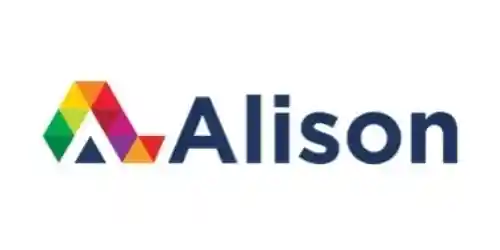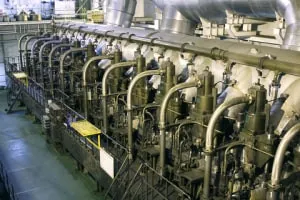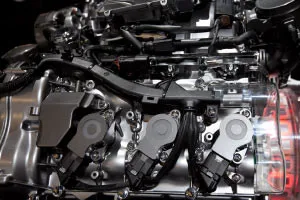
Principles and Constructional Features of Gas Turbines 
Get a comprehesive understanding of Principles and Constructional Features of Gas Turbines. This is a free course from Alison. AZ Class provides this course data for free. Learn more certificate and details here. Discover the intricacies and mechanics of gas turbines with this free online course on the Principles and Constructional Features of Gas Turbines. Dive into the functions of the components, such as the compressor, combustion chamber, and turbine, and explore gas turbine propulsion control systems. Learn about the advantages and disadvantages of gas turbines in marine vessels, including cruise ships and freight carriers. Explore the different cycles used in gas turbines and understand the various types and configurations. Enhance your practical knowledge of gas turbines and improve your skills in marine engineering. Enroll now and unlock the secrets of gas turbine construction. ▼
ADVERTISEMENT
Course Feature
![]() Cost:
Cost:
Free
![]() Provider:
Provider:
Alison
![]() Certificate:
Certificate:
No Information
![]() Language:
Language:
English
Course Overview
❗The content presented here is sourced directly from Alison platform. For comprehensive course details, including enrollment information, simply click on the 'Go to class' link on our website.
Updated in [October 07th, 2023]
What does this course tell?
(Please note that the following overview content is from the original platform)
This free online course covers the intricacies and mechanics of gas turbines and focuses on their marine application. We begin by introducing you to the functions of the components of a gas turbine: the compressor, combustion chamber and turbine. We then discuss the basics of gas turbine propulsion control systems, their advantages and disadvantages and how they are used to propel ships. We analyze the use of gas turbines in merchant marine vessels such as cruise ships, ferries, freight carriers, liquified natural gas carriers and container ships. The course establishes the merits of using gas turbine propulsion plants in commercial tonnage, the technical functions of combined-cycle gas and steam turbine electric (COGES) and the different COGES propulsion-system layouts. We also investigate the current trends in the use of gas turbines in the broader marine industry.
The course then lays out the three primary gas laws and principles that govern gas turbine operation: Bernoulli’s principle, Boyle’s law and Charles’ law, before examining the stages of the convergent-divergent process. We break down the complexities of adiabatic compression, ambient temperature and the importance of compressor cleanliness. We then cover the various cycles used in gas turbines: the Brayton cycle, intercooled cycle, intercooled recuperated cycle, reheat cycle, intercooled reheat cycle and the combined cycle. The course also identifies the different types, working systems and functions of gas turbine configurations, which include single-shaft, split-shaft and twin-spool engines. We establish the necessity of a power turbine for propulsion and describe the single shaft, twin shaft and concentric shaft power turbine. The course then delves into the foundation, enclosure, piping, fuel, lubrication, cooling as well as safety, control, monitoring and alarm systems of gas turbines of various classifications. We then lay out the three main sections of a gas turbine: compressor, combustor and the turbine. This includes explaining the phrases and terms associated with engine inspection and the materials used in the construction of gas turbines, which include special steels, titanium alloys and superalloys. We analyze in detail the working principles, components and types of axial flow and centrifugal compressor to make clear gas turbine coating protection.
This in-depth free online course suits anyone working in marine engineering and will greatly improve your working practical knowledge of the principles that guide the construction and use of gas turbines.
We considered the value of this course from many aspects, and finally summarized it for you from two aspects: skills and knowledge, and the people who benefit from it:
(Please note that our content is optimized through artificial intelligence tools and carefully reviewed by our editorial staff.)
What skills and knowledge will you acquire during this course?
During this course, learners will acquire the following skills and knowledge:
1. Understanding the functions and components of gas turbines, including the compressor, combustion chamber, and turbine.
2. Knowledge of gas turbine propulsion control systems, their advantages, disadvantages, and their application in marine vessels.
3. Familiarity with the use of gas turbines in various merchant marine vessels, such as cruise ships, ferries, freight carriers, liquified natural gas carriers, and container ships.
4. Understanding the technical functions and layouts of combined-cycle gas and steam turbine electric (COGES) propulsion systems.
5. Knowledge of current trends in the use of gas turbines in the broader marine industry.
6. Understanding the three primary gas laws and principles that govern gas turbine operation: Bernoulli’s principle, Boyle’s law, and Charles’ law.
7. Familiarity with the stages of the convergent-divergent process in gas turbines.
8. Understanding adiabatic compression, ambient temperature, and the importance of compressor cleanliness.
9. Knowledge of various cycles used in gas turbines, including the Brayton cycle, intercooled cycle, intercooled recuperated cycle, reheat cycle, intercooled reheat cycle, and combined cycle.
10. Understanding the different types, working systems, and functions of gas turbine configurations, such as single-shaft, split-shaft, and twin-spool engines.
11. Knowledge of power turbines for propulsion, including single shaft, twin shaft, and concentric shaft power turbines.
12. Understanding the foundation, enclosure, piping, fuel, lubrication, cooling, safety, control, monitoring, and alarm systems of gas turbines.
13. Familiarity with the three main sections of a gas turbine: compressor, combustor, and turbine.
14. Knowledge of engine inspection phrases and terms, as well as the materials used in the construction of gas turbines, such as special steels, titanium alloys, and superalloys.
15. Understanding the working principles, components, and types of axial flow and centrifugal compressors.
16. Knowledge of gas turbine coating protection.
Who will benefit from this course?
This course on the principles and constructional features of gas turbines will benefit individuals working in the marine engineering field. Specifically, professionals in the following roles or industries will find value in this course:
1. Marine Engineers: This course provides a comprehensive understanding of gas turbines and their marine applications. Marine engineers will gain practical knowledge on the functions of gas turbine components, propulsion control systems, and the use of gas turbines in different types of merchant marine vessels. This knowledge will enhance their ability to design, operate, and maintain gas turbine propulsion plants in commercial tonnage.
2. Shipbuilders and Shipyard Workers: Shipbuilders and shipyard workers involved in the construction and assembly of marine vessels will benefit from this course. It covers the technical functions of combined-cycle gas and steam turbine electric (COGES) systems and different COGES propulsion-system layouts. This knowledge will enable shipbuilders to incorporate gas turbine propulsion plants effectively into their vessel designs.
3. Gas Turbine Technicians: Gas turbine technicians responsible for the maintenance and repair of gas turbines will find this course valuable. It covers the foundation, enclosure, piping, fuel, lubrication, cooling, safety, control, monitoring, and alarm systems of gas turbines. Additionally, the course explains engine inspection procedures and the materials used in gas turbine construction, including special steels, titanium alloys, and superalloys.
4. Researchers and Academics: Researchers and academics in the field of marine engineering can benefit from this course as it provides in-depth knowledge of gas turbine principles and constructional features. The course covers the three primary gas laws and principles governing gas turbine operation, various gas turbine cycles, and different types of gas turbine configurations. This knowledge can support further research and academic studies in the field.
Course Syllabus
Working Principles of Gas Turbines
In this module, you will be introduced to the components, advantages and disadvantages of a gas turbine, as well as laws and principles that apply to gas turbines. You will also be introduced to Bernoulli's principles, Boyle's law, Charle's law, types of gas turbine cycles. As well as the types of gas turbine configurations which include: single-shaft, split-shaft and twin-spool turbines.Construction and Components of Gas Turbines
In this module, you will be introduced to the constructional features, as well as materials used for the construction of gas turbines they include; special steels, titanium alloys and superalloys. You will also be introduced to the functions of axial flow and centrifugal compressors in gas turbine operations, the two main components of the axial compressor which are; rotor and stator blades>. Along with the types of combustion chambers and oil seals in a gas turbine.Course assessment
Course Provider

Provider Alison's Stats at AZClass
Discussion and Reviews
0.0 (Based on 0 reviews)
Explore Similar Online Courses

Twitter Chat Bot in Python 2023 from Scratch

Carpentry - Introduction to Construction Methods

Python for Informatics: Exploring Information

Social Network Analysis

Introduction to Systematic Review and Meta-Analysis

The Analytics Edge

DCO042 - Python For Informatics

Causal Diagrams: Draw Your Assumptions Before Your Conclusions

Whole genome sequencing of bacterial genomes - tools and applications

Industrial Engineering - Control Valve Basics

Diploma in Marine Diesel Engines


Start your review of Principles and Constructional Features of Gas Turbines